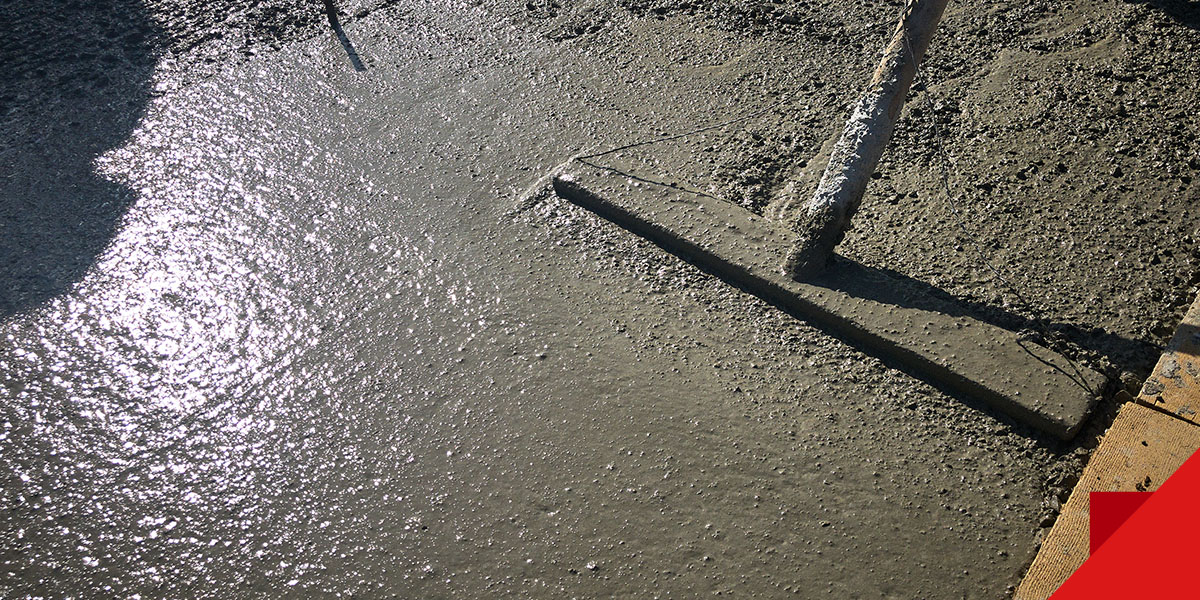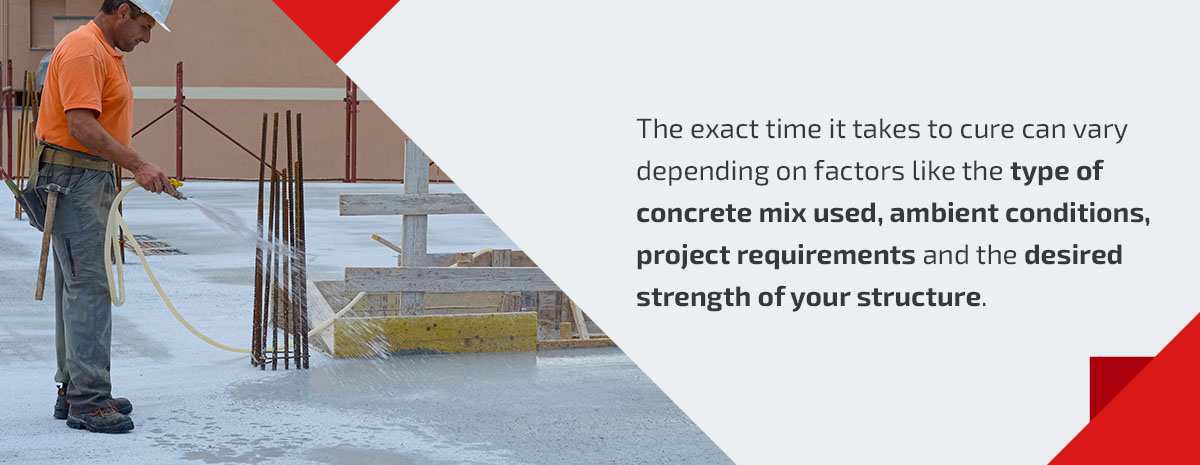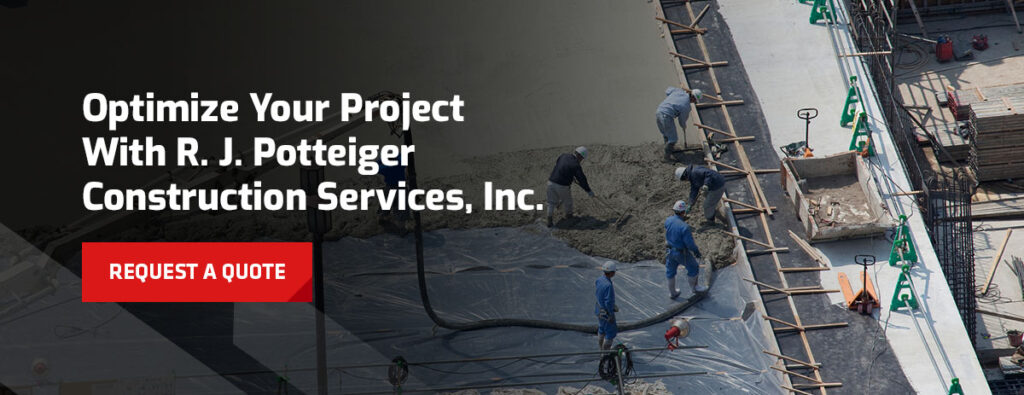The Ultimate Guide to Concrete Curing Time and Techniques

The concrete curing process is essential in creating strong, reliable concrete. In the first week after pouring concrete, you must maintain the right temperatures and moisture levels to cure the structure properly. When cured, the concrete can withstand pressure from people and vehicles, creating a durable and resistant surface. Learn more about how long it takes concrete to dry, curing methods and best practices to ensure successful curing for your construction projects.
What Is Concrete Curing?
Concrete curing involves keeping the right moisture and temperature conditions in place to hydrate the concrete and ensure it gains strength. Curing is the process of the cement and water binding together. Without water, the ingredients can’t create crystals in the concrete matrix, and the structure will lack strength.
Curing is vital in ensuring that concrete reaches its intended strength and resistance. It prevents cracking and improves the concrete’s durability against environmental factors, enhancing its overall performance.
Concrete Curing vs. Concrete Drying
While some may use the terms interchangeably, concrete curing differs from concrete drying. Curing focuses on developing strength and durability, while drying aims to reduce the moisture content from the concrete.
Curing starts immediately after placement, while drying occurs after curing is complete to allow excess moisture to evaporate. Concrete typically takes 24 to 48 hours to dry, though the specific concrete drying time will depend on the temperature and type of concrete mix you use.
Common Methods for Curing Concrete
The proper concrete curing method will ensure optimal hydration and durability of your concrete structures. You can tailor the following curing approaches to your specific project needs and conditions:
Water Curing
Water curing can take on different approaches:
- Sprinkling or ponding method: In this method, you spray or pond water over the concrete surface. Sprinkling is one of the most effective curing methods for preventing the mix water from evaporating.
- Wet covering with plastic sheets: Next, you’ll dampen a covering such as sand, canvas, straw or burlap and place it over the concrete. Cover this with a plastic sheet, creating a barrier to prevent moisture loss.
Membrane Curing
Membrane curing can include the following approaches:
- Use of curing compounds: Curing compounds are liquid formulations you apply to the concrete’s surface. The compounds form a membrane that retains moisture and promotes hydration — an effective curing environment.
- Paper or plastic sheet membranes: In this approach, you’ll place paper or plastic sheet membranes directly on the concrete surface to create a barrier against moisture evaporation, ensuring consistent curing conditions.
Note that you should apply the chemicals as soon as your concrete is finished for the best results when following the membrane curing process.
Steam Curing
Steam curing can accelerate the hydration process and allow the concrete to gain strength much faster. The method involves applying controlled heat and moisture through steam, and it is often used for projects that require expedited curing times or high early strength requirements.
What Is the Curing Time for Concrete?

The exact time it takes to cure can vary depending on factors like the type of concrete mix used, ambient conditions, project requirements and the desired strength of your structure. Initial curing involves keeping the concrete moist and at the appropriate temperature for the first 24 to 48 hours after placement. To achieve sufficient strength and durability, you’ll need to follow the standard curing time of seven days.
In some cases, your project may require extended curing times of up to 28 days or more. For example, concrete structures with specific performance demands, like bridges or industrial floors, may take longer to cure. Other factors like high-strength concrete, large pours, complex designs or harsh environmental conditions can also contribute to extended curing periods for optimal durability.
Factors Affecting Curing Time
The following factors will affect the time it takes to cure concrete:
- Temperature and humidity: The ambient conditions, or temperature and humidity, significantly impact the concrete cure time. Higher temperatures can accelerate the hydration and strength development process while increasing the risk of cracking if not managed properly. Balancing humidity levels to ensure the concrete retains adequate moisture is also critical.
- Thickness and size of the concrete pour: A thicker concrete pour will retain heat generated during hydration for extended periods. This can cause internal temperature differentials and lead to cracking if not managed through extended curing times. Large surface areas in pours can also experience uneven drying rates, requiring you to carefully monitor it and potentially use specialized curing techniques to ensure uniform strength development.
- Type of concrete mix used: Different concrete mixes contain various proportions of cement, water, aggregates and admixtures, which affects their setting and curing characteristics. For instance, specialty mixes like high-strength concrete might have specific curing requirements to achieve their intended properties. Some may require more extended curing periods due to their slower hydration rates.
Properly monitoring and managing the curing process ensures a lasting concrete construction project.
Best Practices for Effective Concrete Curing
Proper curing is critical in achieving the ideal strength, durability and performance of concrete structures. Follow these best practices during the curing process to ensure long-lasting construction:
1. Timely Initiation of Curing Methods
To maintain moisture levels, begin curing immediately after finishing the concrete surface. Avoid delays in applying the curing method to prevent cracking, and apply the curing materials evenly for uniform hydration.
2. Ensuring Proper Moisture Retention
Concrete needs dampness to cure correctly. By replenishing moisture as needed, you prevent the concrete from drying out and increase its strength. However, too much water can provide the opposite effect. So, be sure to let someone with experience assist you during the curing process.
3. Protect From Environmental Factors
Shield the concrete from direct sunlight, wind, high temperatures or low humidity that can accelerate moisture evaporation and affect curing quality. Hot temperatures can make the curing process go too fast, while curing in cold temperatures can slow down or even stop the process. Protect the concrete with a cover to ensure optimal strength.
4. Monitor Curing Conditions
It’s essential to check curing conditions regularly, including the humidity, temperature and moisture levels, and adjust curing methods as needed. Periodically inspecting the process can help ensure uniform moisture distribution and identify and address early signs of curing issues. With professional help, you can ensure your concrete is cured and finished correctly for longevity.
Optimize Your Project With R. J. Potteiger Construction Services, Inc.
Proper curing practices are essential for long-lasting and durable concrete. Concrete curing time will depend on the mix you’re working with, your ambient conditions and the desired strength of your specific project. For this reason, proper monitoring and inspection are critical. When you need help with concrete construction projects, turn to R. J. Potteiger Construction Services, Inc. for effective curing.
We offer various residential and commercial concrete services, from concrete curing to core drilling and saw cutting. No matter your application, we can help you bring your project vision to life. Request a quote online today.




